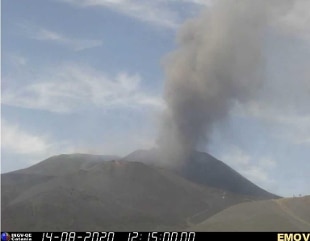Share
14 August 2020 A significant increase in Strombolian activity with the emission of lava ash occurred from the cone of the saddle of the South-East crater of Etna. The 'dark plume' generated, underlines the National Institute of Geophysics and Volcanology - Etna Observatory (Ingv-Oe), is "dispersed by the wind in a south-south-east direction and with a slight fall of ash in the Pedara area, Tre chestnut trees and Viagrande ".Ingv-Oe personnel on the ground report the fallout of coarse pyroclastic material on the flanks of the cone of the New Southeast Crater.
This explosive activity is characterized by persistence and fluctuation in intensity and is coupled with modest ash emissions. From the seismic point of view, the amplitude of the tremor shows variations in the range of average values and, sometimes, in that of high values.
The location of the source of the tremor is confined to the area of the New Southeast Crater, at an altitude of 2,900-3,000 m above sea level. From the infrasonic point of view, no significant activities are reported. From the observation of the parameters relating to the soil deformations, no significant variations are detected. The eruptive activity does not currently impact the operations of the international airport of Catania.

